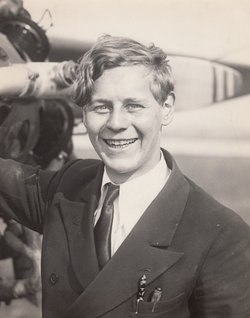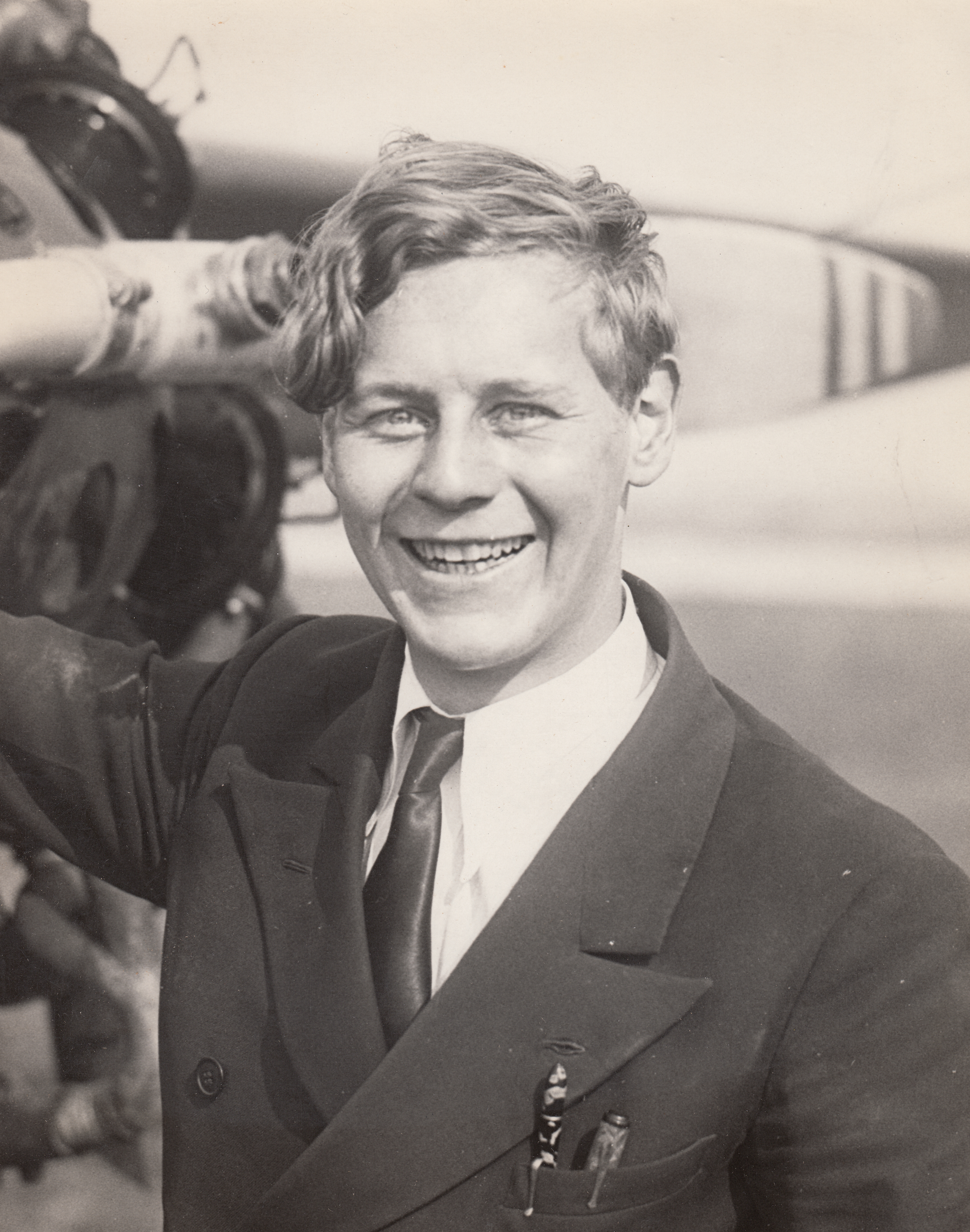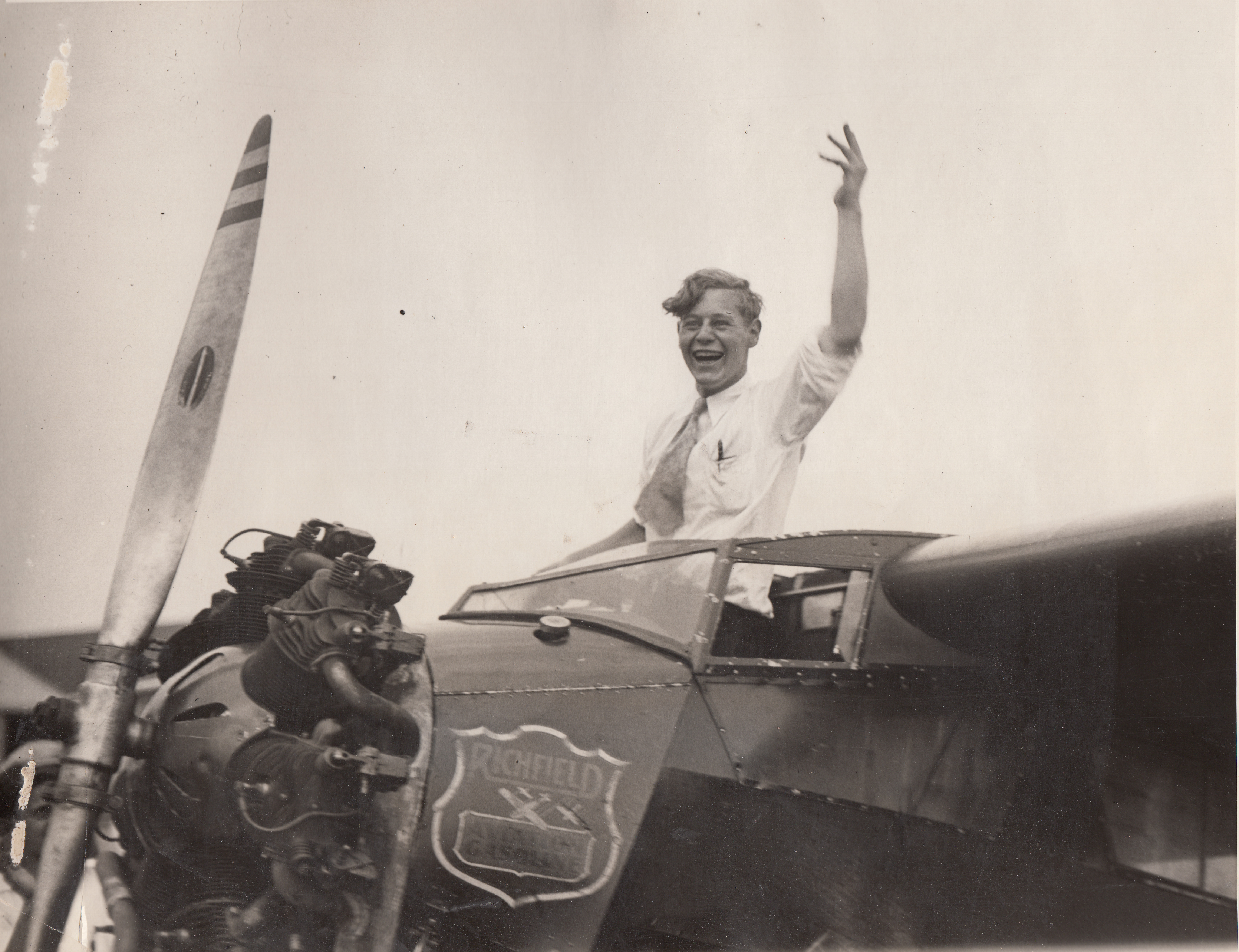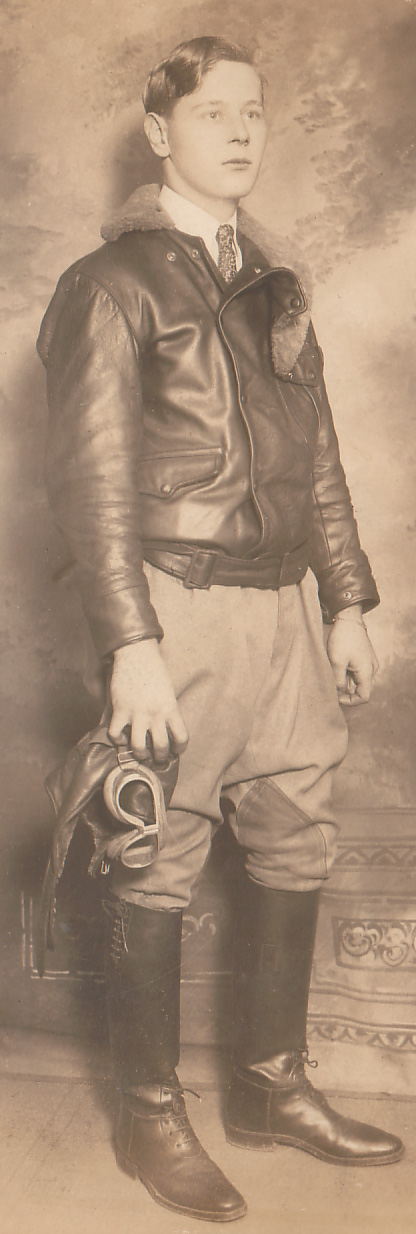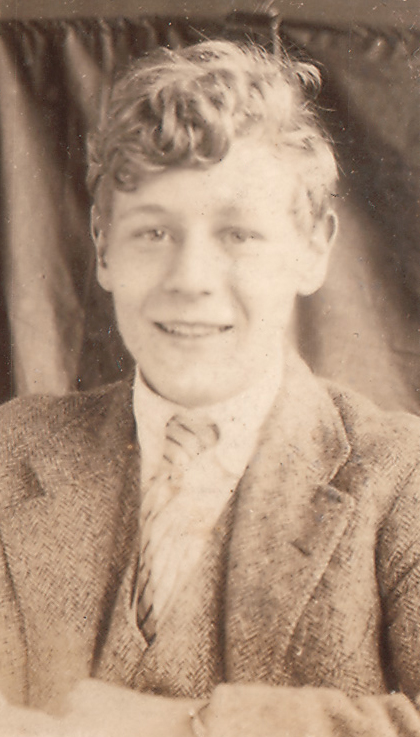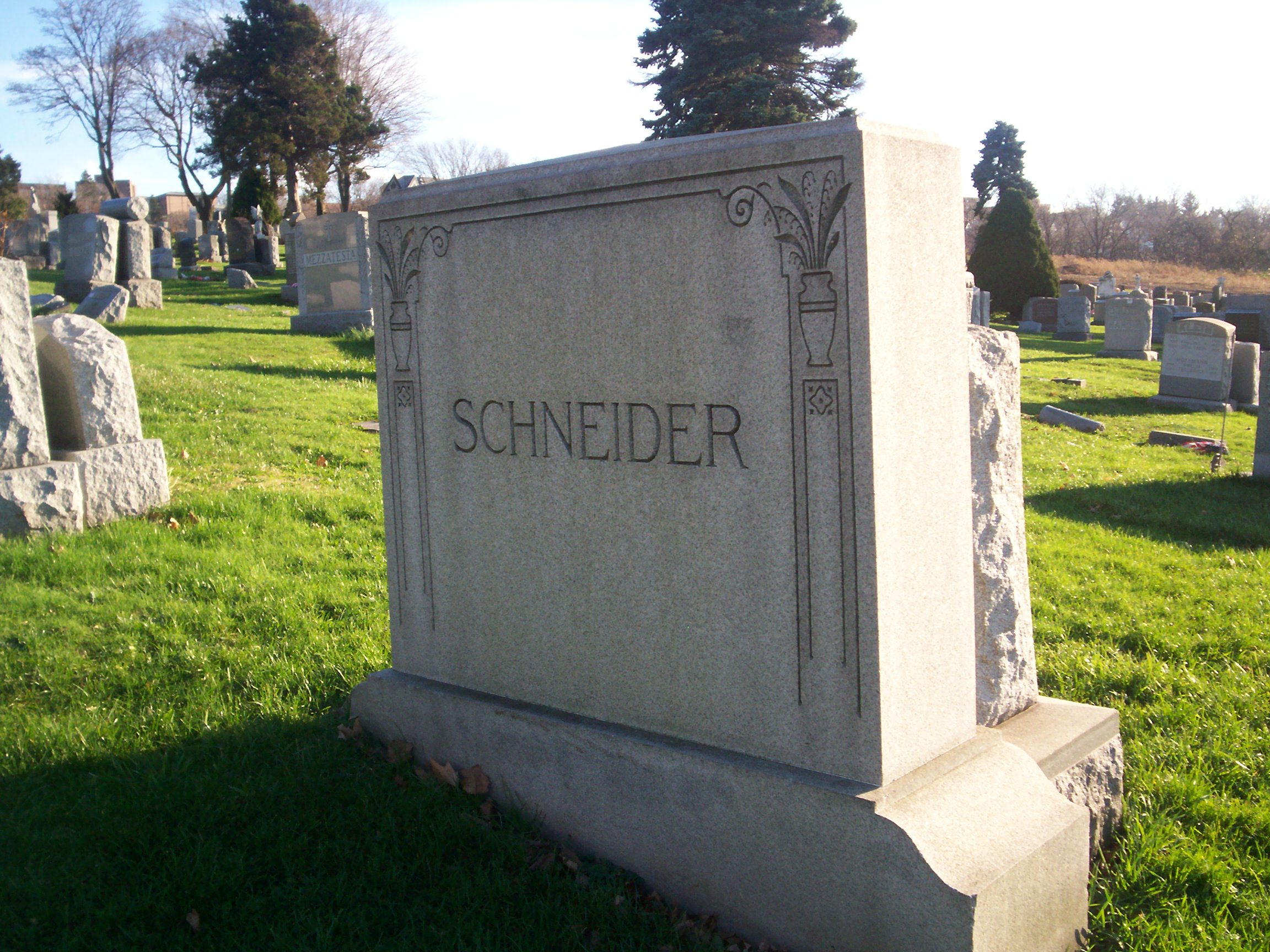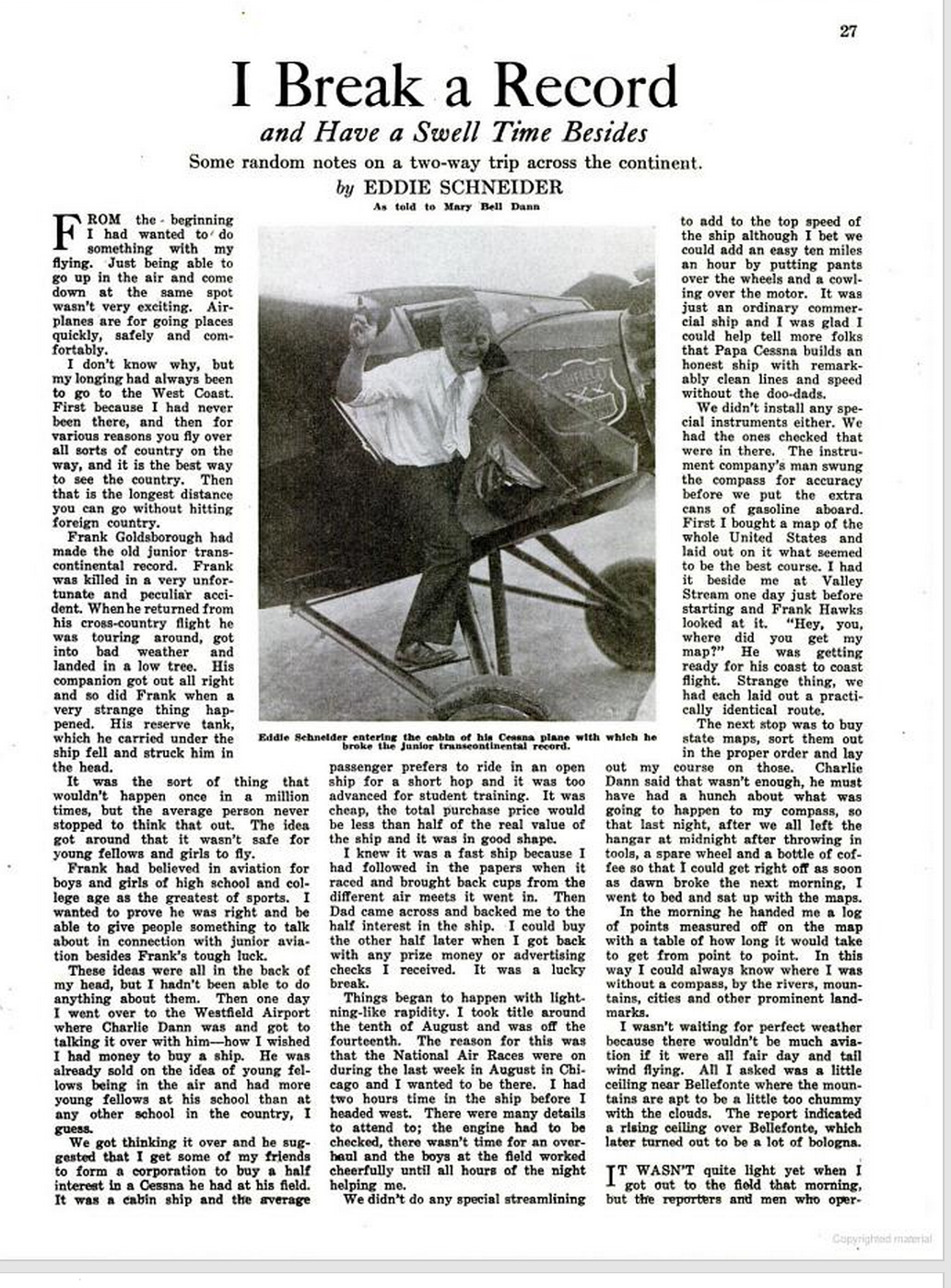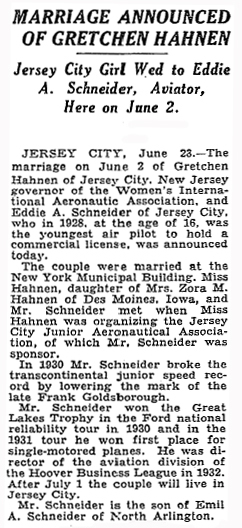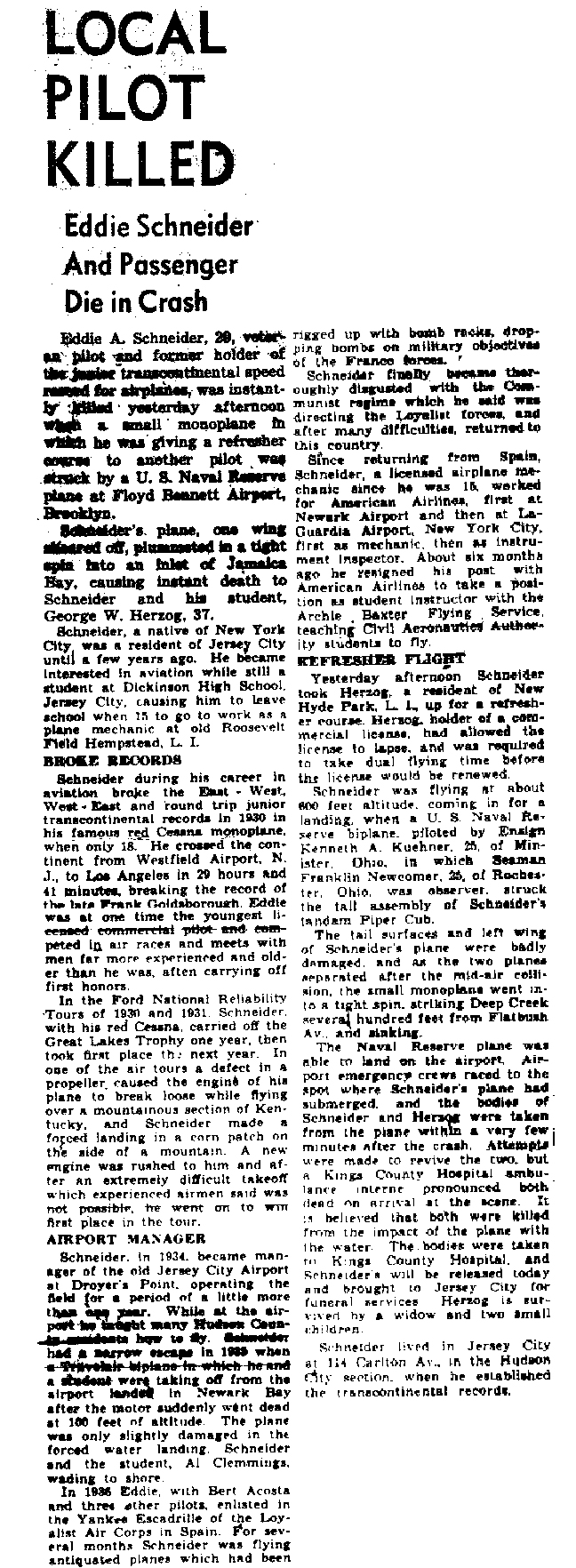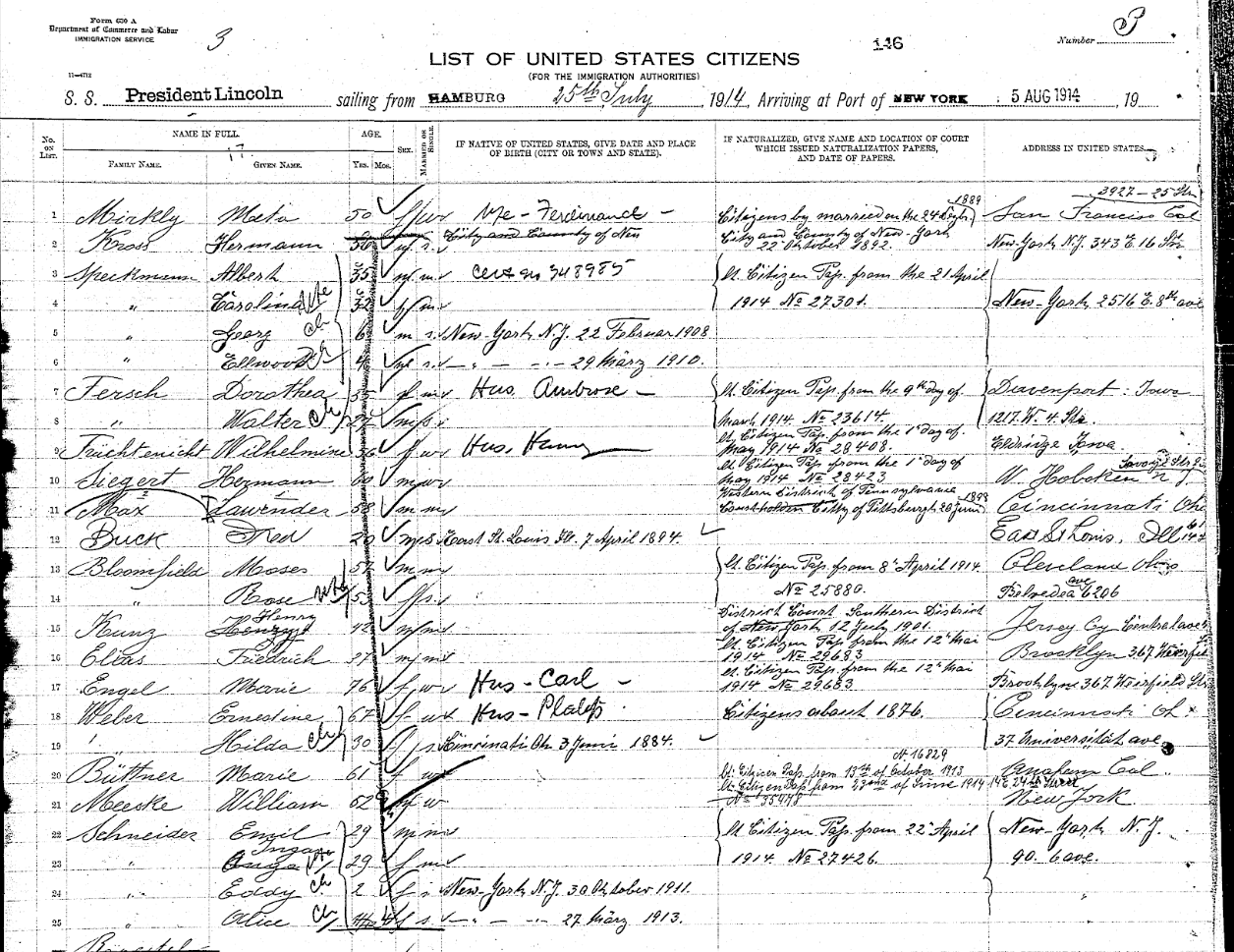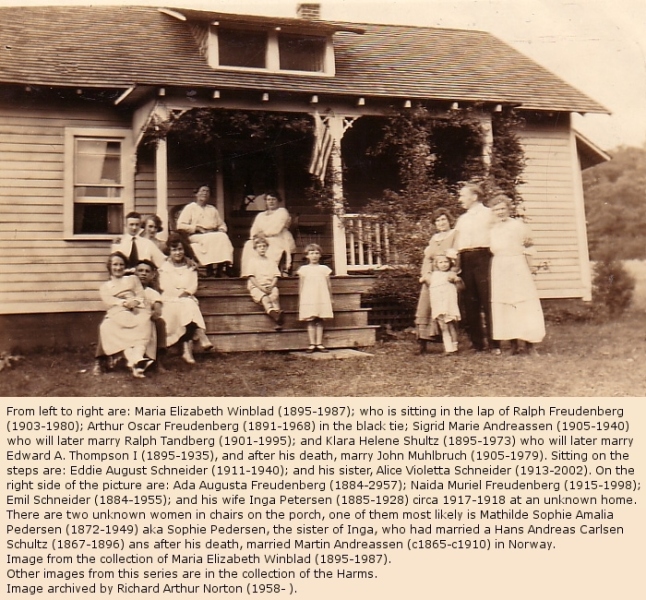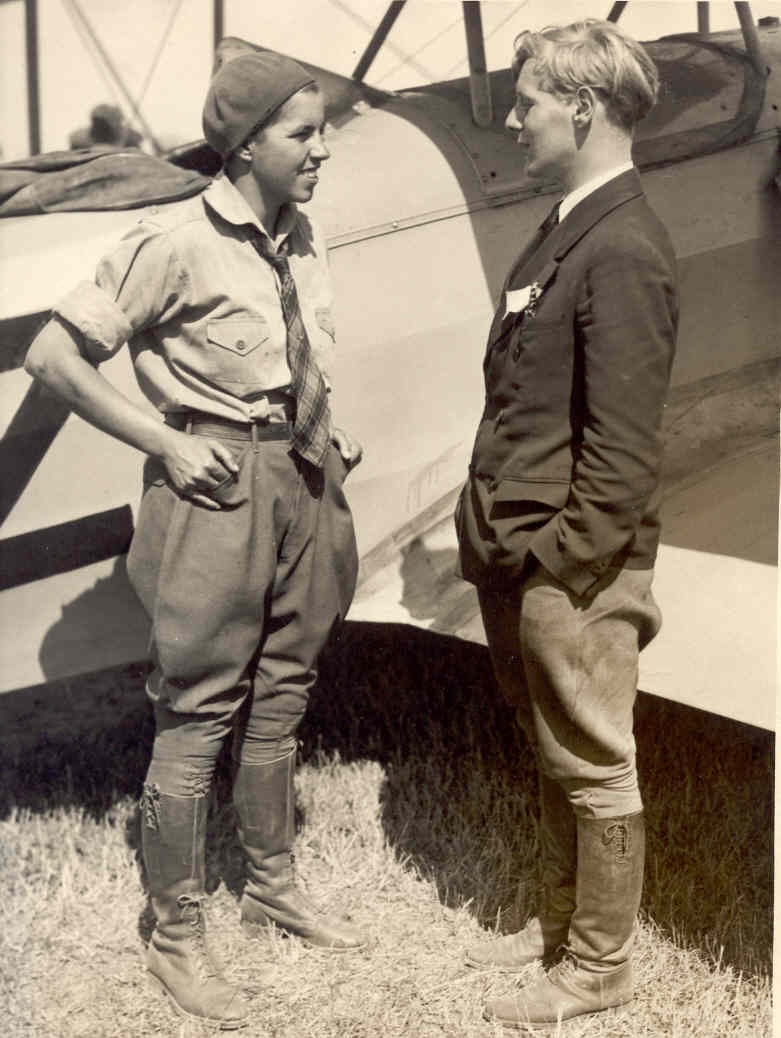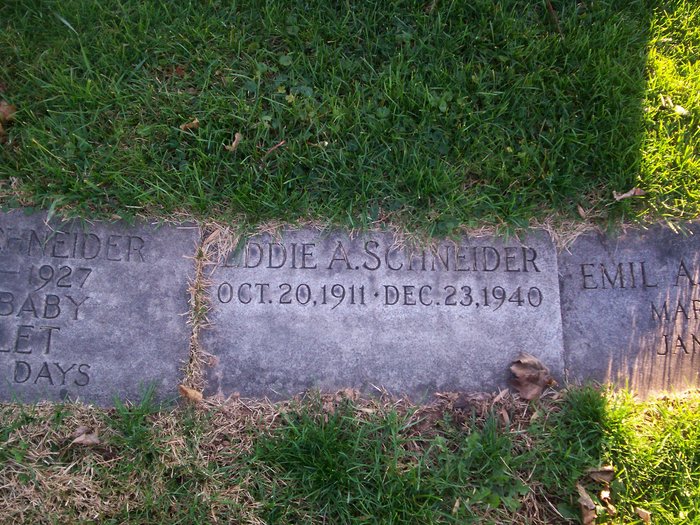Parents:
Emil August Schneider (1886-1955), a banker born in Germany; and Inga Karoline Eldora Pedersen (1885-1927) who was born in Farsund, Norway. His father, Emil, remarried after his wife, Inga, died. Emil's second wife was Margaret Jacobsen (1896-1989), and they had a child.
Birth:
He was born on October 20, 1911 at 2nd Avenue and 17th Street in Manhattan, New York City.
Siblings:
Eddie had one full sibling: Alice Violetta Schneider (1913-2002) who married John Harms (1905-1985).
New York to New Jersey:
The family moved from Manhattan, New York City to Red Bank, Monmouth County, New Jersey and then to Jersey City, Hudson County, New Jersey.
Drop out of school:
Eddie appears to have dropped out of school at age 15, but later graduated from Dickinson High School in Jersey City around 1927 or 1928.
Death of mother:
In 1927 his mother, Inga, died. The remaining family then visited Germany and Norway to be with relatives.
Aviator:
In Germany Eddie went on an airplane ride and then aviation became his obsession. In 1929 he trained at Roosevelt Field on Long Island and became the youngest person in the United States to receive a commercial pilot's license. That same year he also received a mechanics license. In April 1930 Eddie was living in Hempstead, Nassau County, Long Island with a friend named Carl Schenider (1898-?) who was not related. Carl was working as a mechanic. Emil Schneider and Margaret may have been living at 114 Carlton Avenue in Jersey City in 1930. The New York Times reported on July 30, 1930: "Boy Pilot Seeks Record; Jersey City Student Set to Fly to Pacific Coast and Back in August."
Junior transcontinental air speed record:
On August 25, 1930 Eddie set a round-trip transcontinental record for pilots under the age of twenty-one years in his Cessna. The elapsed time was 57 hours, and 14 minutes between Los Angeles and Jersey City. When he landed at Roosevelt Field on Long Island his first words were to his father: "Hello Pop, I made it". The previous record holder was Frank H. Goldsborough (1910-1930) who died in a plane crash on July 16, 1930. Robert Nietzel Buck said on June 28, 2005: "I didn't know him well and only met [him] a couple of times, but I remember him as a quiet, good looking blond, and very modest. I believe he was a credit to aviation and I always admired him."
Junior transcontinental air speed record:
“Schneider Makes Record Flight East. Pilot, 18, Cuts Goldsborough's Junior Coast-To-Coast Mark by 1 1/2 Hours. Lowers Round-Trip Time. Jersey City High School Boy Arrives From Los Angeles In 27 Hours 19 Minutes, Dodging Storm on Way. Roosevelt Field, Long Island; August 24, 1930. In his trim little Cessna monoplane Edward Schneider, 18-year-old high school student, roared across the field here this afternoon, descended in a series of tight spiral turns and touched his wheels at 4:03 to establish new junior transcontinental flying records. Despite two setbacks, one over Kansas when his compass refused to function, and another when a storm overtook him over the treacherous Alleghenies on today's non-stop leg from Columbus, Ohio, the youthful pilot set his flying time between Los Angeles and Roosevelt Field at 27 hours and 36 minutes the former mark of 29 hours 55 minutes set by Frank Goldsborough, who was killed recently in a crash in the White Mountains. Schneider was greeted by his father, Emil A. Schneider, of 114 Carleton Avenue, Jersey City, others of the family and 2,500 enthusiastic Sunday visitors to the field here. He started from Los Angeles last Thursday and made three overnight stops en route. On landing, he said that the storm was on its way here, and stood by while mechanics hurried his plane into a hanger. He said that he was too hungry to talk about his trip. Then when his hunger had been partially appeased by a sandwich the young pilot related his experiences on the last leg of his flight. Weather reports had not been too good when he was ready to take off from Columbus. He counted on an even chance to ‘get through,’ however, and pushed on with the knowledge that he was on the air mail route, with its emergency landing fields and better sectional airports at frequent intervals in case he were forced down. As he neared Uniontown, Pennsylvania, he had to leave the course about thirty miles to the south, he said, to avoid a severe storm which was then over Pittsburgh. As he came up over the Alleghenies, approaching Middletown from the west, a strong headwind was encountered which brought with it s strata of low-hanging clouds. He could not see the ground for a while, he said, as he flew above the clouds rather than hitting one of the mountains. With no landmarks to check by and no radio guidance, he headed for New York by compass and got his next land check near Stroudsbourg, Pennsylvania. Keeping the mail route under him, again he headed for New Brunswick and, finding visibility fair beneath him, he continued on over the flats of New Jersey, the Hudson and East rivers and the outlying sections of New York City. He maintained high attitude so he would be able to wheel and run from thickening weather which was approaching. A few moments after he landed here the skies darkened and mechanics and others on the field rushed their planes into hangers or took precautions to prevent them from being damaged in the approaching storm Schneider and his family left the field almost immediately and motored to their home in Jersey City. In addition to lowering Goldsborough’s record for the trip from Los Angeles to New York Schneider also broke the junior records for the east-west trip last week and the record for the round trip journey concluded today. He left Westfield, New Jersey, last week and, with several overnight stops en route, landed at Los Angeles in 29 hours and 55 minutes of flying time, 4 hours and 22 minutes faster than Goldsborough’s time over the same route. His flying time for the round trip was therefore 57 hours and 14 minutes, against his predecessor’s record of 62 hours and 58 minutes.” (Source: New York Times on August 25, 1930)
National Air Tour:
In 1930 and 1931 Eddie participated in the National Air Tour and he won the Great Lakes Trophy.
Hoover Air League:
In 1932 he worked for the Hoover Air League.
Marriage:
He married Gretchen Hahnen (1902-1986) in Manhattan in New York City on June 2, 1934. Gretchen was originally from Des Moines, Iowa. She was a member the Jersey City Young Woman's Christian Association (YWCA) and was director of the Aviation Club of The Jersey Journal, Junior Club Magazine. Eddie met her at an Aviation Club function. Their certificate was number "14174".
Marriage:
"Eddie Schneider, Gretchen Hahnen, Local Fliers, Report Wedding. The marriage of Miss Gretchen Hahnen, New Jersey governor of the Women's Aeronautic Association, of 208 Sip Avenue, to Eddie A. Schneider, Jersey City aviator, whose home is 58 Van Ripen Avenue, was announced at the informal reception Saturday evening. The couple were married Saturday, June 2 in the New York Municipal Building. Mrs. Schneider, who at one time conducted a column on aviation in The Jersey Journal, was the organizer of the Jersey City Junior Aeronautical Association. and conducted a radio program an aviation. Schneider. when he first learned to fly in 1928 at Roosevelt Field, was the youngest licensed commercial pilot. He received his instruction from the late Bill Ulbrich, pilot of the ill-fated 'American Nurse,' which disappeared several years ago an a flight from New York to Rome. The young Jersey City pilot first became recognized as a long-distance tier when he broke the junior trans-continental speed record, formerly held by the late Frank Goldsborough. He flew from New York to Los Angeles in 27 hours, and made the return trip in 27 hours. In the Ford national air reliability tour of 1930 Schneider carried off the Great Lakes Trophy for small planes_ He was an entrant in the speed dash from Los Angeles to Cleveland in 1931. A year later Schneider was director of the Aviation Division, Hoover Business League. He was later connected with the aviation division of an oil concern, and at present is Hudson County representative for an oil-burner concern. He has taken part in air shows in many parts of the country and on more than one occasion has thrilled Hudson County residents with his air stunts at Jersey City Airport, Droyers Point. Mrs. Schneider is the daughter of Mrs. Zora M. Hahnen, of Jersey City and Des Moines, Iowa. She is a native of Des Moines. Schneider, born in Jersey City, is the son of Emil A. Schneider of North Arlington." (Source: Jersey Journal of Jersey City, New Jersey on June 25, 1934)
Marriage:
"Schneider, Flier, Wed To Gretchen Hahnen. New York City; June 15, 1934 (Associated Press) Eddie A. Schneider, 23, an aviator and Miss Gretchen A. Hahnen, 39, New Jersey Governor of the Woman's International Aeronautics Association were married in the Municipal Chapel June 2, a search of the records today disclosed. They obtained their license the same day and the ceremony was performed by Deputy City Clerk Philip A. Nines, although publication was withheld. In applying for the license, Schneider said he was a salesman and gave his address as 44 West 75th Street. The bride gave her occupation as that of a clerk and said the resided at 208 Sip Avenue, Jersey City, New Jersey. She said she was a daughter of Herme F. Hahnen, of Des Moines, Iowa. Four years ago, Schneider, then 19, clipped an hour and a half from the late Frank Goldsborough's junior record of 28 hours and 18 minutes for a West-East transcontinental flight." (Source: Associated Press in the Trenton Times of Trenton, New Jersey on June 25, 1934 )
Jersey City Airport:
In 1935 Eddie leased the Jersey City Airport and ran his flying school from there until the field was converted into a stadium. The New York Times reported on September 26, 1935 on page 08: "Mayor Frank Hague of Jersey City announced yesterday he had been informed that the Works Progress Administration had approved the city's application for an $800,000 grant to build a municipal sports stadium."
1935 crash:
"Two In Plane Escape In Newark Bay Crash. Two aviators escaped with only minor bruises and a thorough wetting last night when their three-seat, open-cockpit biplane developed motor trouble soon after taking off from the Jersey City Airport and fell into Newark Bay 200 feet off Droyer's Point, Jersey City. The men were rescued by police, who went to their aid in a collapsible rowboat kept at the field. The plane [had] taken off at 7 pm [piloted] by Edward Schneider, 23 years old, of 209 Sip Avenue, Jersey City, former holder of the junior transcontinental plane record and manager of the airport since January 1, 1935. Schneider had as a passenger, Fred Weigel, 31, of 77 Lembeck Avenue, Jersey City, a flying student. Schneider said later at the Administration building, where he and Weigel were drying their clothes, that the plane had not gained more than 100 feet altitude when the engine failed. He could not explain the motor trouble. Schneider said he guided the plane to the water which was eight feet deep at that point. The plane struck and sank into the mud bottom, while Schneider and Weigel floundered about in the water and finally got on top of a wing. Persons at the airport had seen the accident and called the police. Schneider and Weigel refused medical attention. Schneider said the plane, which was secured to the shore by ropes, would be salvaged today." (Source: New York Times on May 16, 1935 )
Spanish Civil War:
On November 11, 1936, Eddie left for Spain to fly for the Loyalists in the Revolution. He was living at 50 Jones Street in Jersey City at the time. Eddie was never paid what he was promised and he returned to the US in January of 1937. On January 01, 1937 the New York Times reported: "With stories of each other's adventures and none about their own, Bert Acosta, Gordon Berry, Eddie Schneider and Frederick Lord returned to Paris this morning from two months' experience in the civil war in Spain." The New York Times on January 16, 1937 stated the following: "Eddie Schneider, 25-year-old aviator, who recently returned to the United States after serving a month in the so-called Yankee Squadron with the Spanish Loyalists, said yesterday that a New York lawyer had negotiated with him for his services abroad." In the late editions of The New York Times on January 16, 1937, and in the early edition of January 17, 1937 there appeared an item concerning the return of Eddie Schneider, aviator, from serving a month in the so-called Yankee Squadron with the Spanish Loyalists and Schneider's appearance at the Federal Building, where he was questioned by John F. Dailey Jr., Chief Assistant United States [Attorney].
Spanish Civil War:
"Flier Says Lawyer Sent Him to Spain. Schneider names New Yorker as giving him ticket to join loyalist army. Promised $1,500 a month, but he was never paid, so he quit, witness declares - tells story to U.S. officials. Eddie Schneider, 25-year-old aviator, who recently returned to the United States after serving a month in the so-called Yankee Squadron with the Spanish Loyalists, said yesterday that a New York lawyer had negotiated with him for his services abroad. Schneider, who began his career as a flier in 1928, appeared at the Federal Building, where he was questioned by John F. Dailey Jr., Chief Assistant United States Attorney. Mr. Dailey, who last Thursday questioned Bert Acosta and Gordon K. Berry, both of whom served in the same squadron, is conducting an investigation to determine if the service of the Yankee Squadron in Spain was a violation of a federal statute. That statute provides: 'Whoever, within the territory or jurisdiction of the United States, enlists or enters himself, or hires or retains another person to enlist or enter himself, or to go beyond the limits or jurisdiction of the United States with intent to be enlisted or entered in the service of any foreign prince, state colony, district or people as a soldier or as a marine, or seaman on board of any vessel of war, letter or marquee, or privateer, shall be fined not more than $1,000 and imprisoned not more than 4 years.' According to Schneider, the lawyer told him that he would be paid $1,500 a month for his services in the air force and would receive a bonus of $1,000 for every Rebel plane he shot down. The lawyer, he said, gave him his steamship ticket. Schneider, in an interview with newspapermen, said that he had quit Spain because the Loyalist Government had not carried out its obligations under a contract signed in Valencia. The only money he received, he said, came from the Spanish Embassy in Paris, which paid his fare back to the United States. Colonel Lewis Landes, attorney for Schneider, interrupted to say on behalf of his client that Schneider had really quit Spain because he wished to comply with President Roosevelt's neutrality program. Schneider said that Major Thomas Lamphier was still abroad flying for the Loyalists. He said that he himself had taken part in bombing raids daily for about three weeks. The bombers, he said were remodeled sport planes, and the bombs were dropped through floor openings." (Source: New York Times on January 16, 1937)
American Airlines:
In 1940 Eddie stood at 68 inches and weighed 158 pounds. He had blond hair and blue eyes and had a scar on his right thumb. In June of 1940 he began work for American Airlines at Newark airport in New Jersey. He then moved to Jackson Heights on Long Island, when American Airlines eastern terminal moved to LaGuardia Field. He took a job as a civilian instructor for the US Army at Floyd Bennett Field in Brooklyn with the Archie Baxter Flying Service.
Death in plane crash:
On December 23, 1940, Eddie was killed in a training accident at Floyd Bennett Field at age 29 when he was training George W. Herzog (c1900-1940). He was flying at about 600 feet, about to land when Navy pilot Kenneth A. Kuehner, age 25, of Minister, Ohio struck the tail assembly of Eddie's Piper Cub. Eddie's plane went into a spin and crashed into Deep Creek just off Flatbush Avenue. Both Herzog and Schneider were dead at the scene of impact. The bodies were taken to King's County Hospital. His obituary appeared in the Jersey Journal and The New York Times on December 24, 1940. His death certificate lists the cause of death as "crushed chest & abdomen; hemothorax & hemoperitoneum: in aeroplane crash". He was living at 3250 93rd Street in Brooklyn when he died. His Death Certificate number was "25366" and his Medical Examiner Case Number was "4418".
Funeral:
Air Buddies to Strew Rose on Schneider Grave. Following funeral services tonight in Jersey City, interment services will be held tomorrow afternoon at Fairview Cemetery, Fairview, for Eddie A. Schneider, Jersey City aviator, who was instantly, killed Monday afternoon in a midair collision over Floyd Bennett Airport, Brooklyn. A plane, piloted, by Schneider, was struck by a Naval Reserve plane as the two ships were at an altitude of 600 feet, both coming in for a landing. Schneider, a resident of Jersey City for 23, years before moving to Jackson Heights less than a year ago, became a pilot when 15 and established It a new transcontinental speed record for junior pilots when 18. In 1936 he went to Spain as a pilot in the Loyalist Air Force and flew a bomber for several months. Pilots from Roosevelt Field and Floyd Bennett Airport will fly over Fairview Cemetery tomorrow afternoon and drop roses from the plane in a parting tribute to their fellow flyer. Schneider learned how to fly at Roosevelt Field from the late Bill Ulbrich, who lost his life while attempting a trans-Atlantic flight in the ill-fated "American Nurse." Schneider is survived by his widow, the former Gretchen Hahnen; his parents, Mr. and Mrs. Emil A. Schneider, of Arlington; a sister, Mres. Alice Harms, and a half-sister, Miss Eleanor Schneider. (Source: Jersey Journal of Jersey City, New Jersey on December 26, 1940)
Biography:
"Eddie Schneider was born October 20, 1911 on Second Avenue, and 17th Street in New York City. Later his family moved to Red Bank, New Jersey where he attended grade school. From there his family moved to Jersey City, New Jersey and he graduated from Dickinson High School. In 1928 his mother passed away and his father took him, and his sister, for a visit to Germany and Norway to visit relatives. It was in Germany that he had his first airplane flight and it was then the "bug" bit him. Eddie received his flying instructions at Roosevelt Field in 1928. In October 1929 he received his commercial pilot's license and so became the youngest commercial pilot in the United States at age eighteen. He also received in that year, his aircraft and engine mechanic's license and so again he became the youngest licensed aircraft mechanic. In August 1930 he succeeded in breaking Frank Goldsborough's Junior Transcontinental record from New York to Los Angeles in 29 hours and 55 minutes, lowering the previous record by 4 hours and 22 minutes. He made the return trip in 27 hours and 19 minutes, lowering the previous record by 1 hour and 36 minutes. His total time for the round trip was 57 hours and 14 minutes, thus breaking the preceding record for the round trip, which was 62 hours and 58 minutes. His A.I.I. license was signed personally by Wilbur Wright. Following his transcontinental flight, Eddie flew to Chicago where he was one of the outstanding personalities at the National Air Races. While there, he was highly complimented for his ability to avoid an air crash over the crowded grandstand, a crash which had it occurred, would have cost a number of lives. Schneider had just taken off in his Cessna (with a Warner Scarab engine) monoplane from the Chicago field bound for the balloon races at Cleveland, when he saw the crowd scatter below. Noticing the panic, he looked up and saw the 40 foot left wing of a twenty passenger Buranelli transport plane directly over his. The youthful aviator saw passengers in the Buranelli scramble to the other side of the cabin to tilt the the sloping wing. The danger of the crash was great, and in an instant, Schneider sent his plane diving just as the Buranelli's wing scraped his. The crash was averted by the dip. The officials said his quick action in dipping his plane close to the ground and then pulling clear of the grandstand had probably averted the most serious accident in the races. He then entered in the Ford National Reliability Tour, the youngest pilot to have ever been so honored by an aircraft company. These tours were in reality efficiency races for commercial airplanes flying over a course of five thousand miles, which undoubtedly made these races the longest commercial aircraft races in the world. Schneider completed the tour with further honors, winning first place for single engine aircraft and the Great Lakes Trophy. Incidentally, he was the first pilot to fly a Cessna throughout the itinerary. Others had been entered in previous tours, but none had finished. Returning to New York, Schneider put in considerable time appearing in smaller air shows, where he attracted hordes of boys and girls to whom he spoke on any and all occasions, impressing upon them always the fact that any one of them could do what he was doing; that aviation belonged to them; that they should grasp the opportunity presented to them. In 1931, the Ford National Reliability Air Tour found Eddie once again a Cessna entry. During the race, the propeller broke and, causing him to lose his engine and so forced him out of the race for three days. This happened over the mountains of Kentucky. After pleading and cajoling with the Warner Company in Detroit, he made the necessary repairs with a new propeller and had been given permission to reenter the race. Naturally when he reentered the race, he found himself in last place and way behind the leaders, but he gained on his fellow pilots until on the last day, he found himself in first place again for a single engine aircraft and was the winner the second time of the Great Lakes Trophy. In 1932 he became chief pilot for the Hoover Business League. After that he became a student instructor until 1935 when he leased the Jersey City Airport in New Jersey and managed it and conducted his own flying school, aerial photography and charter work. At that time he one of the largest flying schools in the East with over one hundred and twenty-five students. And so he carried on. No flying club was too small or insignificant to win his willing cooperation in the furtherance of their plans. It was at the meeting of the Jersey Journal Model Plane Club that he met his wife, Gretchen Hahnen, who then lived in Jersey City, but was from Des Moine, Iowa. They were married in New York City on June 02, 1934. In December 1935, after a unsuccessful battle to save Jersey City Airport from becoming a stadium, he did exhibition flights and was an instructor at several New Jersey airports. By 1936, flying jobs were hard to come by. Schneider was "invited" to go to Spain and fly for the Spanish Loyalists. He accompanied Bert Acosta, Gordon Berry and Freddie Lord. They left New York on November 11, 1936 and arrived in Spain a week or so later. There he flew antiquated planes, but got disgusted and gave up, and came home, in January 1937. Between then and June of 1940 he became a mechanic for American Airlines at La Guardia Field, but his heart was not into it, he wanted to fly. He applied to the US Government for a job as a civilian instructor for the Army and was assigned to Floyd Bennett Field in Brooklyn. On December 23, 1940, while instructing a student and coming in for a landing, he was hit in the rear by a Navy Stearman which brought Eddie, and his student, to their untimely death. When the Navy plane landed, it still had Schneider's plane's left wing in their undercarriage. And so, aviation, as an industry, owes a debt of gratitude to it's younger contingent, such as Frank Goldsborough, Bob Buck and Dick James and others who followed, and to these youthful trail blazers who were constantly winning new recruits to the ranks of those who look upon aviation as a part of themselves and to whom the industry must continue to look for its new leaders." (Source: Gretchen Hahnen in 1952)
Obituary:
New York Times: "2 Die As Planes Crash At Field. Eddie Schneider, who started flying when he was 15 years old and set a junior transcontinental record in 1930 at the age of 18, was killed with a student passenger yesterday when their light training plane was in collision with a Naval Reserve plane, also on a training flight, just west of Floyd Bennett Field. The Naval Reserve plane landed safely at the field but Schneider's plane went into a spin, tore off a wing, and crashed into Deep Creek, a few hundred feet across Flatbush Avenue from the city airport in Brooklyn. Both Schneider and his passenger, George W. Herzog, 37, a contractor living at 535 North Second Street, New Hyde Park, Long Island, were dead when their bodies were pulled from the submerged wreckage. At the Naval Reserve base at Floyd Bennett Field it was said the Navy biplane, a Stearman trainer, had been piloted by Ensign Kenneth A, Kuehner, 25, of Minister, Ohio, with Second Class Seaman Frank Newcomer, of Rochester, Ohio, as a passenger. The right lower wing of the naval plane, the left upper wing and the propeller were damaged. The third accident, in two weeks in which a Naval Reserve plane based at Floyd Bennett Field was involved, it brought the comment from Dock Commissioner John McKenzie that it was the sort of thing to be expected "where there are training: flights at an airport." "That is the point that Mayor La Guardia has been making". Mr. McKenzie said, 'in his efforts to keep training away from commercial fields.' Police said the witnesses to the accident were agreed that the Naval Reserve plane was crossing above the plane piloted by Schneider, a high-wing Piper Tandem Cub monoplane, as the two approached the field for a landing 600 feet above Deep Creek, Schneider's plane went into a tight spin as the two planes disengaged after colliding, the witnesses said, appeared to straighten out and then plummeted into the water as its left wing tore loose. Many would-be rescuers were on the scene within, a few moments, including police, Coast Guardsmen and fliers from Floyd Bennett Field. The bodies of the two men were pulled quickly from the wreckage and onto a half-submerged barge near which the plane fell, but it appeared both had been killed when the plane hit the water. Joseph Hanley, first assistant district attorney of Kings County, opened an investigation at the scene and a naval board of inquiry, headed by Commander H. R. Bowes, was ordered convened by the Navy Department in Washington. Schneider lived at 32-50 Seventy-third Street, Jackson Heights, Queens. He leaves a widow. Herzog leaves a widow and two children. He had been flying some time, holding a limited commercial pilot's license, but had enrolled for a refresher course with the Archie Baxter Flying Service, Inc., owner of the plane. Schneider was an instructor at the school. The bodies of the two men were taken to Floyd Bennett Field pending funeral arrangements. Schneider first gained public attention as a flier in the Summer of 1930 when he announced plans for an attempt to break the junior transcontinental east-west record of 34 hours 57 minutes set the year before by 15-year-old Frank Goldsborough, who was later killed. Taking off from Westfield, New Jersey, August 14, he landed at Los Angeles four days later with a new elapsed time mark of 29 hours 55 minutes. He then flew the west-east passage in 27 hours 19 minutes to better Goldsborough's time for that flight and also for the round trip. He continued active in aviation, competing in National Air Tours, races, and as an instructor. He went to Spain in 1936 to fly for the Loyalists, but returned the next year without having collected the $1,500-a-month pay that was promised him. He and other American fliers were looked on with suspicion by many of the Loyalists, he said, because they were not Communists. Schneider had a narrow escape from death May 15, 1935, when the engine of his training plane failed and it fell into Newark Bay with him and a student passenger shortly after they had taken off from Jersey City Airport, of which he then was manager. Schneider's father, Emil, a Jersey City banker, financed his son's transcontinental flight after having first opposed his efforts to become a flier. The boy had quit school at 15 and worked as a mechanic at Roosevelt Field, Mineola, Long Island, and at the Westfield airport to secure money for flying lessons. He was the youngest licensed flier in the country when he received a limited commercial license shortly after his eighteenth birthday in 1929."
Obituary:
Jersey Journal: "Local Pilot Killed. Eddie Schneider and Passenger Die in Crash. Eddie A. Schneider, 29, veteran pilot and former holder of the junior transcontinental speed record for airplanes, was instantly killed yesterday afternoon when a small monoplane in which he was giving a refresher course to another pilot was struck by U.S. Naval Reserve plane at Floyd Bennett Airport, Brooklyn. Schneider's plane, one wing sheared off, plummeted in a tight spin into an inlet of Jamaica Bay, causing instant death to Schneider and his student, George W. Herzog, 37. Schneider, a native of New York City was a resident of Jersey City until a few years ago. He became interested in aviation while still a student at Dickenson High School, Jersey City, causing him to leave school when 15 to go to work as a plane mechanic at old Roosevelt Field Hempstead, Long Island. Schneider during his career in aviation broke the East-West, West-East and round trip junior transcontinental records in 1930 in his famous red Cessna monoplane, when only 18. He crossed the continent from Westfield Airport, New Jersey, to Los Angeles in 29 hours and 41 minutes, breaking the record of the late Frank Goldsborough. Eddie was at one time the youngest licensed commercial pilot and competed in air races and meets with men far more experienced and older than he was, after carrying off first honors. In the Ford National Reliability Tours of 1930 and 1931. Schneider with his red Cessna, carried off the Great Lakes Trophy one year, and then took first place the next year. In one of the air tours a defect in a propeller caused the engine of his plane to break loose while flying over a mountainous section of Kentucky, and Schneider made a forced landing in a corn patch on a side of the mountain. A new engine was rushed to him and after an extremely difficult takeoff, which experienced airmen, said was not possible, he went on to win first place in the tour. Schneider in 1934 became the manager of the old Jersey City Airport at Droyers Point, operating the filed for a period of a little more than a year. While at the airport he taught many Hudson County students how to fly. Schneider had a narrow escape in 1935 when a Travelair biplane in which he and a student were taking off from the airport landed in Newark Bay after the motor suddenly went dead at 100 feet of attitude. The plane was only slightly damaged in the forced water landing. Schneider and the student Al Clemmings, wading to shore. In 1936 Eddie with Bert Acosta and three other pilots, enlisted in the Yankee Escadrille of the Loyalist Air Corps in Spain. For several months Schneider was flying antiquated planes, which had been rigged up with racks, dropping bombs on military objectives of the Franco forces. Schneider finally became thoroughly disgusted with the Communist regime, which he said was directing the Loyalist forces, and after many difficulties, returned to this country. Since returning from Spain, Schneider, a licensed airplane mechanic since he was 15, worked for American Airlines, first at Newark Airport and then at La Guardia Airport, New York City, first as a mechanic, then as instrument inspector. About six months ago he resigned his post with American Airlines to take a position as student instructor with the Archie Baxter Flying Service teaching Civil Aeronautics Authority students to fly. Yesterday afternoon Schneider took Herzog, a resident of New Hyde Park, Long Island, up for a refresher course. Herzog, holder of a commercial license, had allowed the license to lapse, and was required to take dual flying time before his license would be renewed. Schneider was flying at about 600 feet altitude, coming in for a landing, when a United States Naval Reserve biplane piloted by Ensign Kenneth A, Kuehler, 25, of Rochester, Ohio, was observer, struck the tail assembly of Schneider's tandem Piper Cub. The tails surfaces and left wing of Schneider's plane were badly damaged and as the two planes separated after the mid-air collision, the small monoplane went in a tight spin, striking Deep Creek several hundred feet from Flatbush Avenue and sinking. The Naval Reserve plane was able to land at the airport. Airport emergency crews raced to the spot where Schneider's plane had submerged and the bodies of Schneider and Herzog were taken from the plane within a very few minutes after the crash. Attempts were made to to revive the two, but a Kings County Hospital ambulance intern pronounced both dead on arrival at the scene. It is believed that both were killed by the impact of the plane with the water. The bodies were taken to Kings County Hospital and Schneider will be released today and brought to Jersey City for funeral services. Herzog is survived by a widow and two small children. Schneider lived in Jersey City at 114 Carlton Avenue in the Hudson City section when he established the transcontinental records."
Archive:
Eddie's papers and photographs are archived at the George H. Williams World War I Aviation Library at The University of Texas at Dallas. They archived his New York and New Jersey driver's licenses; his Trans World Airline (TWA) Courtesy Card; 1940 Selective Service card; and 1942 Federal Communications Commission (FCC) license.
Eddie Schneider Memorial Library:
"A former Des Moines woman has just presented her late first husband's aviation trophies, books, scrap-books, etc., to the Smithsonian Institution where they will be cataloged in his name as the Eddie Schneider Memorial Library. Eddie Schneider, who was killed in a 1940 plane crash at New York when he was 33, was a veteran of transcontinental speed races, winner of the Great Lakes trophy, and one of four American leaders of the Yankee squadron that fought for loyalist Spain. Schneider's widow, now Mrs. Grant Black of Fort Worth, Texas, was Gretchen Hahnen of Des Moines, daughter of Mrs. Zora M. Hahnen, 2915 Logan." (Source: Des Moines Tribune of Des Moines, Iowa on 26 September 1952)
Rediscovery:
Both Selma Louise Freudenberg (1921-2009) of Jersey City, New Jersey and Muriel Elaine Jensen (1928- ) of Chicago, Illinois knew of Eddie Schneider and was told he was related to the family somehow. The relationship is through Eddie's mother who was from Farsund, Norway. Selma's sister had a photograph and a newspaper clipping of Eddie which initiated this research. Richard Arthur Norton writes in 2017: "My mom told me he was related, but I knew the entire German side of my family, and he did not fit in. I was in Chicago at a family reunion for the Norwegian side of the family in 2005, and someone asked who Eddie Schneider was. He said he was taken up in his airplane in Chicago in 1930 or 1931. That made me start researching him. I found his obituary in the New York Times which gave me his death date, so I ordered his death certificate. When I got his death certificate, I saw his mother was Norwegian. I then ordered her death certificate and saw that her father was in the family tree."
Relationship:
Eddie August Schneider (1911-1940) was the second cousin, twice removed of Richard Arthur Norton (1958- ); and was the second cousin, twice removed of Judith Kaye Grothe (1947- ).
Research:
Researched and written by Richard Arthur Norton (1958- ) for Findagrave starting on April 15, 2004. Updated on March 4, 2017 with the anecdote on his rediscovery. Updated on October 8, 2019 with information on the Eddie Schneider Memorial Library at the Smithsonian Institution. Updated on Halloween, October 31, 2019 with text about his funeral and his marriage.
.
Parents:
Emil August Schneider (1886-1955), a banker born in Germany; and Inga Karoline Eldora Pedersen (1885-1927) who was born in Farsund, Norway. His father, Emil, remarried after his wife, Inga, died. Emil's second wife was Margaret Jacobsen (1896-1989), and they had a child.
Birth:
He was born on October 20, 1911 at 2nd Avenue and 17th Street in Manhattan, New York City.
Siblings:
Eddie had one full sibling: Alice Violetta Schneider (1913-2002) who married John Harms (1905-1985).
New York to New Jersey:
The family moved from Manhattan, New York City to Red Bank, Monmouth County, New Jersey and then to Jersey City, Hudson County, New Jersey.
Drop out of school:
Eddie appears to have dropped out of school at age 15, but later graduated from Dickinson High School in Jersey City around 1927 or 1928.
Death of mother:
In 1927 his mother, Inga, died. The remaining family then visited Germany and Norway to be with relatives.
Aviator:
In Germany Eddie went on an airplane ride and then aviation became his obsession. In 1929 he trained at Roosevelt Field on Long Island and became the youngest person in the United States to receive a commercial pilot's license. That same year he also received a mechanics license. In April 1930 Eddie was living in Hempstead, Nassau County, Long Island with a friend named Carl Schenider (1898-?) who was not related. Carl was working as a mechanic. Emil Schneider and Margaret may have been living at 114 Carlton Avenue in Jersey City in 1930. The New York Times reported on July 30, 1930: "Boy Pilot Seeks Record; Jersey City Student Set to Fly to Pacific Coast and Back in August."
Junior transcontinental air speed record:
On August 25, 1930 Eddie set a round-trip transcontinental record for pilots under the age of twenty-one years in his Cessna. The elapsed time was 57 hours, and 14 minutes between Los Angeles and Jersey City. When he landed at Roosevelt Field on Long Island his first words were to his father: "Hello Pop, I made it". The previous record holder was Frank H. Goldsborough (1910-1930) who died in a plane crash on July 16, 1930. Robert Nietzel Buck said on June 28, 2005: "I didn't know him well and only met [him] a couple of times, but I remember him as a quiet, good looking blond, and very modest. I believe he was a credit to aviation and I always admired him."
Junior transcontinental air speed record:
“Schneider Makes Record Flight East. Pilot, 18, Cuts Goldsborough's Junior Coast-To-Coast Mark by 1 1/2 Hours. Lowers Round-Trip Time. Jersey City High School Boy Arrives From Los Angeles In 27 Hours 19 Minutes, Dodging Storm on Way. Roosevelt Field, Long Island; August 24, 1930. In his trim little Cessna monoplane Edward Schneider, 18-year-old high school student, roared across the field here this afternoon, descended in a series of tight spiral turns and touched his wheels at 4:03 to establish new junior transcontinental flying records. Despite two setbacks, one over Kansas when his compass refused to function, and another when a storm overtook him over the treacherous Alleghenies on today's non-stop leg from Columbus, Ohio, the youthful pilot set his flying time between Los Angeles and Roosevelt Field at 27 hours and 36 minutes the former mark of 29 hours 55 minutes set by Frank Goldsborough, who was killed recently in a crash in the White Mountains. Schneider was greeted by his father, Emil A. Schneider, of 114 Carleton Avenue, Jersey City, others of the family and 2,500 enthusiastic Sunday visitors to the field here. He started from Los Angeles last Thursday and made three overnight stops en route. On landing, he said that the storm was on its way here, and stood by while mechanics hurried his plane into a hanger. He said that he was too hungry to talk about his trip. Then when his hunger had been partially appeased by a sandwich the young pilot related his experiences on the last leg of his flight. Weather reports had not been too good when he was ready to take off from Columbus. He counted on an even chance to ‘get through,’ however, and pushed on with the knowledge that he was on the air mail route, with its emergency landing fields and better sectional airports at frequent intervals in case he were forced down. As he neared Uniontown, Pennsylvania, he had to leave the course about thirty miles to the south, he said, to avoid a severe storm which was then over Pittsburgh. As he came up over the Alleghenies, approaching Middletown from the west, a strong headwind was encountered which brought with it s strata of low-hanging clouds. He could not see the ground for a while, he said, as he flew above the clouds rather than hitting one of the mountains. With no landmarks to check by and no radio guidance, he headed for New York by compass and got his next land check near Stroudsbourg, Pennsylvania. Keeping the mail route under him, again he headed for New Brunswick and, finding visibility fair beneath him, he continued on over the flats of New Jersey, the Hudson and East rivers and the outlying sections of New York City. He maintained high attitude so he would be able to wheel and run from thickening weather which was approaching. A few moments after he landed here the skies darkened and mechanics and others on the field rushed their planes into hangers or took precautions to prevent them from being damaged in the approaching storm Schneider and his family left the field almost immediately and motored to their home in Jersey City. In addition to lowering Goldsborough’s record for the trip from Los Angeles to New York Schneider also broke the junior records for the east-west trip last week and the record for the round trip journey concluded today. He left Westfield, New Jersey, last week and, with several overnight stops en route, landed at Los Angeles in 29 hours and 55 minutes of flying time, 4 hours and 22 minutes faster than Goldsborough’s time over the same route. His flying time for the round trip was therefore 57 hours and 14 minutes, against his predecessor’s record of 62 hours and 58 minutes.” (Source: New York Times on August 25, 1930)
National Air Tour:
In 1930 and 1931 Eddie participated in the National Air Tour and he won the Great Lakes Trophy.
Hoover Air League:
In 1932 he worked for the Hoover Air League.
Marriage:
He married Gretchen Hahnen (1902-1986) in Manhattan in New York City on June 2, 1934. Gretchen was originally from Des Moines, Iowa. She was a member the Jersey City Young Woman's Christian Association (YWCA) and was director of the Aviation Club of The Jersey Journal, Junior Club Magazine. Eddie met her at an Aviation Club function. Their certificate was number "14174".
Marriage:
"Eddie Schneider, Gretchen Hahnen, Local Fliers, Report Wedding. The marriage of Miss Gretchen Hahnen, New Jersey governor of the Women's Aeronautic Association, of 208 Sip Avenue, to Eddie A. Schneider, Jersey City aviator, whose home is 58 Van Ripen Avenue, was announced at the informal reception Saturday evening. The couple were married Saturday, June 2 in the New York Municipal Building. Mrs. Schneider, who at one time conducted a column on aviation in The Jersey Journal, was the organizer of the Jersey City Junior Aeronautical Association. and conducted a radio program an aviation. Schneider. when he first learned to fly in 1928 at Roosevelt Field, was the youngest licensed commercial pilot. He received his instruction from the late Bill Ulbrich, pilot of the ill-fated 'American Nurse,' which disappeared several years ago an a flight from New York to Rome. The young Jersey City pilot first became recognized as a long-distance tier when he broke the junior trans-continental speed record, formerly held by the late Frank Goldsborough. He flew from New York to Los Angeles in 27 hours, and made the return trip in 27 hours. In the Ford national air reliability tour of 1930 Schneider carried off the Great Lakes Trophy for small planes_ He was an entrant in the speed dash from Los Angeles to Cleveland in 1931. A year later Schneider was director of the Aviation Division, Hoover Business League. He was later connected with the aviation division of an oil concern, and at present is Hudson County representative for an oil-burner concern. He has taken part in air shows in many parts of the country and on more than one occasion has thrilled Hudson County residents with his air stunts at Jersey City Airport, Droyers Point. Mrs. Schneider is the daughter of Mrs. Zora M. Hahnen, of Jersey City and Des Moines, Iowa. She is a native of Des Moines. Schneider, born in Jersey City, is the son of Emil A. Schneider of North Arlington." (Source: Jersey Journal of Jersey City, New Jersey on June 25, 1934)
Marriage:
"Schneider, Flier, Wed To Gretchen Hahnen. New York City; June 15, 1934 (Associated Press) Eddie A. Schneider, 23, an aviator and Miss Gretchen A. Hahnen, 39, New Jersey Governor of the Woman's International Aeronautics Association were married in the Municipal Chapel June 2, a search of the records today disclosed. They obtained their license the same day and the ceremony was performed by Deputy City Clerk Philip A. Nines, although publication was withheld. In applying for the license, Schneider said he was a salesman and gave his address as 44 West 75th Street. The bride gave her occupation as that of a clerk and said the resided at 208 Sip Avenue, Jersey City, New Jersey. She said she was a daughter of Herme F. Hahnen, of Des Moines, Iowa. Four years ago, Schneider, then 19, clipped an hour and a half from the late Frank Goldsborough's junior record of 28 hours and 18 minutes for a West-East transcontinental flight." (Source: Associated Press in the Trenton Times of Trenton, New Jersey on June 25, 1934 )
Jersey City Airport:
In 1935 Eddie leased the Jersey City Airport and ran his flying school from there until the field was converted into a stadium. The New York Times reported on September 26, 1935 on page 08: "Mayor Frank Hague of Jersey City announced yesterday he had been informed that the Works Progress Administration had approved the city's application for an $800,000 grant to build a municipal sports stadium."
1935 crash:
"Two In Plane Escape In Newark Bay Crash. Two aviators escaped with only minor bruises and a thorough wetting last night when their three-seat, open-cockpit biplane developed motor trouble soon after taking off from the Jersey City Airport and fell into Newark Bay 200 feet off Droyer's Point, Jersey City. The men were rescued by police, who went to their aid in a collapsible rowboat kept at the field. The plane [had] taken off at 7 pm [piloted] by Edward Schneider, 23 years old, of 209 Sip Avenue, Jersey City, former holder of the junior transcontinental plane record and manager of the airport since January 1, 1935. Schneider had as a passenger, Fred Weigel, 31, of 77 Lembeck Avenue, Jersey City, a flying student. Schneider said later at the Administration building, where he and Weigel were drying their clothes, that the plane had not gained more than 100 feet altitude when the engine failed. He could not explain the motor trouble. Schneider said he guided the plane to the water which was eight feet deep at that point. The plane struck and sank into the mud bottom, while Schneider and Weigel floundered about in the water and finally got on top of a wing. Persons at the airport had seen the accident and called the police. Schneider and Weigel refused medical attention. Schneider said the plane, which was secured to the shore by ropes, would be salvaged today." (Source: New York Times on May 16, 1935 )
Spanish Civil War:
On November 11, 1936, Eddie left for Spain to fly for the Loyalists in the Revolution. He was living at 50 Jones Street in Jersey City at the time. Eddie was never paid what he was promised and he returned to the US in January of 1937. On January 01, 1937 the New York Times reported: "With stories of each other's adventures and none about their own, Bert Acosta, Gordon Berry, Eddie Schneider and Frederick Lord returned to Paris this morning from two months' experience in the civil war in Spain." The New York Times on January 16, 1937 stated the following: "Eddie Schneider, 25-year-old aviator, who recently returned to the United States after serving a month in the so-called Yankee Squadron with the Spanish Loyalists, said yesterday that a New York lawyer had negotiated with him for his services abroad." In the late editions of The New York Times on January 16, 1937, and in the early edition of January 17, 1937 there appeared an item concerning the return of Eddie Schneider, aviator, from serving a month in the so-called Yankee Squadron with the Spanish Loyalists and Schneider's appearance at the Federal Building, where he was questioned by John F. Dailey Jr., Chief Assistant United States [Attorney].
Spanish Civil War:
"Flier Says Lawyer Sent Him to Spain. Schneider names New Yorker as giving him ticket to join loyalist army. Promised $1,500 a month, but he was never paid, so he quit, witness declares - tells story to U.S. officials. Eddie Schneider, 25-year-old aviator, who recently returned to the United States after serving a month in the so-called Yankee Squadron with the Spanish Loyalists, said yesterday that a New York lawyer had negotiated with him for his services abroad. Schneider, who began his career as a flier in 1928, appeared at the Federal Building, where he was questioned by John F. Dailey Jr., Chief Assistant United States Attorney. Mr. Dailey, who last Thursday questioned Bert Acosta and Gordon K. Berry, both of whom served in the same squadron, is conducting an investigation to determine if the service of the Yankee Squadron in Spain was a violation of a federal statute. That statute provides: 'Whoever, within the territory or jurisdiction of the United States, enlists or enters himself, or hires or retains another person to enlist or enter himself, or to go beyond the limits or jurisdiction of the United States with intent to be enlisted or entered in the service of any foreign prince, state colony, district or people as a soldier or as a marine, or seaman on board of any vessel of war, letter or marquee, or privateer, shall be fined not more than $1,000 and imprisoned not more than 4 years.' According to Schneider, the lawyer told him that he would be paid $1,500 a month for his services in the air force and would receive a bonus of $1,000 for every Rebel plane he shot down. The lawyer, he said, gave him his steamship ticket. Schneider, in an interview with newspapermen, said that he had quit Spain because the Loyalist Government had not carried out its obligations under a contract signed in Valencia. The only money he received, he said, came from the Spanish Embassy in Paris, which paid his fare back to the United States. Colonel Lewis Landes, attorney for Schneider, interrupted to say on behalf of his client that Schneider had really quit Spain because he wished to comply with President Roosevelt's neutrality program. Schneider said that Major Thomas Lamphier was still abroad flying for the Loyalists. He said that he himself had taken part in bombing raids daily for about three weeks. The bombers, he said were remodeled sport planes, and the bombs were dropped through floor openings." (Source: New York Times on January 16, 1937)
American Airlines:
In 1940 Eddie stood at 68 inches and weighed 158 pounds. He had blond hair and blue eyes and had a scar on his right thumb. In June of 1940 he began work for American Airlines at Newark airport in New Jersey. He then moved to Jackson Heights on Long Island, when American Airlines eastern terminal moved to LaGuardia Field. He took a job as a civilian instructor for the US Army at Floyd Bennett Field in Brooklyn with the Archie Baxter Flying Service.
Death in plane crash:
On December 23, 1940, Eddie was killed in a training accident at Floyd Bennett Field at age 29 when he was training George W. Herzog (c1900-1940). He was flying at about 600 feet, about to land when Navy pilot Kenneth A. Kuehner, age 25, of Minister, Ohio struck the tail assembly of Eddie's Piper Cub. Eddie's plane went into a spin and crashed into Deep Creek just off Flatbush Avenue. Both Herzog and Schneider were dead at the scene of impact. The bodies were taken to King's County Hospital. His obituary appeared in the Jersey Journal and The New York Times on December 24, 1940. His death certificate lists the cause of death as "crushed chest & abdomen; hemothorax & hemoperitoneum: in aeroplane crash". He was living at 3250 93rd Street in Brooklyn when he died. His Death Certificate number was "25366" and his Medical Examiner Case Number was "4418".
Funeral:
Air Buddies to Strew Rose on Schneider Grave. Following funeral services tonight in Jersey City, interment services will be held tomorrow afternoon at Fairview Cemetery, Fairview, for Eddie A. Schneider, Jersey City aviator, who was instantly, killed Monday afternoon in a midair collision over Floyd Bennett Airport, Brooklyn. A plane, piloted, by Schneider, was struck by a Naval Reserve plane as the two ships were at an altitude of 600 feet, both coming in for a landing. Schneider, a resident of Jersey City for 23, years before moving to Jackson Heights less than a year ago, became a pilot when 15 and established It a new transcontinental speed record for junior pilots when 18. In 1936 he went to Spain as a pilot in the Loyalist Air Force and flew a bomber for several months. Pilots from Roosevelt Field and Floyd Bennett Airport will fly over Fairview Cemetery tomorrow afternoon and drop roses from the plane in a parting tribute to their fellow flyer. Schneider learned how to fly at Roosevelt Field from the late Bill Ulbrich, who lost his life while attempting a trans-Atlantic flight in the ill-fated "American Nurse." Schneider is survived by his widow, the former Gretchen Hahnen; his parents, Mr. and Mrs. Emil A. Schneider, of Arlington; a sister, Mres. Alice Harms, and a half-sister, Miss Eleanor Schneider. (Source: Jersey Journal of Jersey City, New Jersey on December 26, 1940)
Biography:
"Eddie Schneider was born October 20, 1911 on Second Avenue, and 17th Street in New York City. Later his family moved to Red Bank, New Jersey where he attended grade school. From there his family moved to Jersey City, New Jersey and he graduated from Dickinson High School. In 1928 his mother passed away and his father took him, and his sister, for a visit to Germany and Norway to visit relatives. It was in Germany that he had his first airplane flight and it was then the "bug" bit him. Eddie received his flying instructions at Roosevelt Field in 1928. In October 1929 he received his commercial pilot's license and so became the youngest commercial pilot in the United States at age eighteen. He also received in that year, his aircraft and engine mechanic's license and so again he became the youngest licensed aircraft mechanic. In August 1930 he succeeded in breaking Frank Goldsborough's Junior Transcontinental record from New York to Los Angeles in 29 hours and 55 minutes, lowering the previous record by 4 hours and 22 minutes. He made the return trip in 27 hours and 19 minutes, lowering the previous record by 1 hour and 36 minutes. His total time for the round trip was 57 hours and 14 minutes, thus breaking the preceding record for the round trip, which was 62 hours and 58 minutes. His A.I.I. license was signed personally by Wilbur Wright. Following his transcontinental flight, Eddie flew to Chicago where he was one of the outstanding personalities at the National Air Races. While there, he was highly complimented for his ability to avoid an air crash over the crowded grandstand, a crash which had it occurred, would have cost a number of lives. Schneider had just taken off in his Cessna (with a Warner Scarab engine) monoplane from the Chicago field bound for the balloon races at Cleveland, when he saw the crowd scatter below. Noticing the panic, he looked up and saw the 40 foot left wing of a twenty passenger Buranelli transport plane directly over his. The youthful aviator saw passengers in the Buranelli scramble to the other side of the cabin to tilt the the sloping wing. The danger of the crash was great, and in an instant, Schneider sent his plane diving just as the Buranelli's wing scraped his. The crash was averted by the dip. The officials said his quick action in dipping his plane close to the ground and then pulling clear of the grandstand had probably averted the most serious accident in the races. He then entered in the Ford National Reliability Tour, the youngest pilot to have ever been so honored by an aircraft company. These tours were in reality efficiency races for commercial airplanes flying over a course of five thousand miles, which undoubtedly made these races the longest commercial aircraft races in the world. Schneider completed the tour with further honors, winning first place for single engine aircraft and the Great Lakes Trophy. Incidentally, he was the first pilot to fly a Cessna throughout the itinerary. Others had been entered in previous tours, but none had finished. Returning to New York, Schneider put in considerable time appearing in smaller air shows, where he attracted hordes of boys and girls to whom he spoke on any and all occasions, impressing upon them always the fact that any one of them could do what he was doing; that aviation belonged to them; that they should grasp the opportunity presented to them. In 1931, the Ford National Reliability Air Tour found Eddie once again a Cessna entry. During the race, the propeller broke and, causing him to lose his engine and so forced him out of the race for three days. This happened over the mountains of Kentucky. After pleading and cajoling with the Warner Company in Detroit, he made the necessary repairs with a new propeller and had been given permission to reenter the race. Naturally when he reentered the race, he found himself in last place and way behind the leaders, but he gained on his fellow pilots until on the last day, he found himself in first place again for a single engine aircraft and was the winner the second time of the Great Lakes Trophy. In 1932 he became chief pilot for the Hoover Business League. After that he became a student instructor until 1935 when he leased the Jersey City Airport in New Jersey and managed it and conducted his own flying school, aerial photography and charter work. At that time he one of the largest flying schools in the East with over one hundred and twenty-five students. And so he carried on. No flying club was too small or insignificant to win his willing cooperation in the furtherance of their plans. It was at the meeting of the Jersey Journal Model Plane Club that he met his wife, Gretchen Hahnen, who then lived in Jersey City, but was from Des Moine, Iowa. They were married in New York City on June 02, 1934. In December 1935, after a unsuccessful battle to save Jersey City Airport from becoming a stadium, he did exhibition flights and was an instructor at several New Jersey airports. By 1936, flying jobs were hard to come by. Schneider was "invited" to go to Spain and fly for the Spanish Loyalists. He accompanied Bert Acosta, Gordon Berry and Freddie Lord. They left New York on November 11, 1936 and arrived in Spain a week or so later. There he flew antiquated planes, but got disgusted and gave up, and came home, in January 1937. Between then and June of 1940 he became a mechanic for American Airlines at La Guardia Field, but his heart was not into it, he wanted to fly. He applied to the US Government for a job as a civilian instructor for the Army and was assigned to Floyd Bennett Field in Brooklyn. On December 23, 1940, while instructing a student and coming in for a landing, he was hit in the rear by a Navy Stearman which brought Eddie, and his student, to their untimely death. When the Navy plane landed, it still had Schneider's plane's left wing in their undercarriage. And so, aviation, as an industry, owes a debt of gratitude to it's younger contingent, such as Frank Goldsborough, Bob Buck and Dick James and others who followed, and to these youthful trail blazers who were constantly winning new recruits to the ranks of those who look upon aviation as a part of themselves and to whom the industry must continue to look for its new leaders." (Source: Gretchen Hahnen in 1952)
Obituary:
New York Times: "2 Die As Planes Crash At Field. Eddie Schneider, who started flying when he was 15 years old and set a junior transcontinental record in 1930 at the age of 18, was killed with a student passenger yesterday when their light training plane was in collision with a Naval Reserve plane, also on a training flight, just west of Floyd Bennett Field. The Naval Reserve plane landed safely at the field but Schneider's plane went into a spin, tore off a wing, and crashed into Deep Creek, a few hundred feet across Flatbush Avenue from the city airport in Brooklyn. Both Schneider and his passenger, George W. Herzog, 37, a contractor living at 535 North Second Street, New Hyde Park, Long Island, were dead when their bodies were pulled from the submerged wreckage. At the Naval Reserve base at Floyd Bennett Field it was said the Navy biplane, a Stearman trainer, had been piloted by Ensign Kenneth A, Kuehner, 25, of Minister, Ohio, with Second Class Seaman Frank Newcomer, of Rochester, Ohio, as a passenger. The right lower wing of the naval plane, the left upper wing and the propeller were damaged. The third accident, in two weeks in which a Naval Reserve plane based at Floyd Bennett Field was involved, it brought the comment from Dock Commissioner John McKenzie that it was the sort of thing to be expected "where there are training: flights at an airport." "That is the point that Mayor La Guardia has been making". Mr. McKenzie said, 'in his efforts to keep training away from commercial fields.' Police said the witnesses to the accident were agreed that the Naval Reserve plane was crossing above the plane piloted by Schneider, a high-wing Piper Tandem Cub monoplane, as the two approached the field for a landing 600 feet above Deep Creek, Schneider's plane went into a tight spin as the two planes disengaged after colliding, the witnesses said, appeared to straighten out and then plummeted into the water as its left wing tore loose. Many would-be rescuers were on the scene within, a few moments, including police, Coast Guardsmen and fliers from Floyd Bennett Field. The bodies of the two men were pulled quickly from the wreckage and onto a half-submerged barge near which the plane fell, but it appeared both had been killed when the plane hit the water. Joseph Hanley, first assistant district attorney of Kings County, opened an investigation at the scene and a naval board of inquiry, headed by Commander H. R. Bowes, was ordered convened by the Navy Department in Washington. Schneider lived at 32-50 Seventy-third Street, Jackson Heights, Queens. He leaves a widow. Herzog leaves a widow and two children. He had been flying some time, holding a limited commercial pilot's license, but had enrolled for a refresher course with the Archie Baxter Flying Service, Inc., owner of the plane. Schneider was an instructor at the school. The bodies of the two men were taken to Floyd Bennett Field pending funeral arrangements. Schneider first gained public attention as a flier in the Summer of 1930 when he announced plans for an attempt to break the junior transcontinental east-west record of 34 hours 57 minutes set the year before by 15-year-old Frank Goldsborough, who was later killed. Taking off from Westfield, New Jersey, August 14, he landed at Los Angeles four days later with a new elapsed time mark of 29 hours 55 minutes. He then flew the west-east passage in 27 hours 19 minutes to better Goldsborough's time for that flight and also for the round trip. He continued active in aviation, competing in National Air Tours, races, and as an instructor. He went to Spain in 1936 to fly for the Loyalists, but returned the next year without having collected the $1,500-a-month pay that was promised him. He and other American fliers were looked on with suspicion by many of the Loyalists, he said, because they were not Communists. Schneider had a narrow escape from death May 15, 1935, when the engine of his training plane failed and it fell into Newark Bay with him and a student passenger shortly after they had taken off from Jersey City Airport, of which he then was manager. Schneider's father, Emil, a Jersey City banker, financed his son's transcontinental flight after having first opposed his efforts to become a flier. The boy had quit school at 15 and worked as a mechanic at Roosevelt Field, Mineola, Long Island, and at the Westfield airport to secure money for flying lessons. He was the youngest licensed flier in the country when he received a limited commercial license shortly after his eighteenth birthday in 1929."
Obituary:
Jersey Journal: "Local Pilot Killed. Eddie Schneider and Passenger Die in Crash. Eddie A. Schneider, 29, veteran pilot and former holder of the junior transcontinental speed record for airplanes, was instantly killed yesterday afternoon when a small monoplane in which he was giving a refresher course to another pilot was struck by U.S. Naval Reserve plane at Floyd Bennett Airport, Brooklyn. Schneider's plane, one wing sheared off, plummeted in a tight spin into an inlet of Jamaica Bay, causing instant death to Schneider and his student, George W. Herzog, 37. Schneider, a native of New York City was a resident of Jersey City until a few years ago. He became interested in aviation while still a student at Dickenson High School, Jersey City, causing him to leave school when 15 to go to work as a plane mechanic at old Roosevelt Field Hempstead, Long Island. Schneider during his career in aviation broke the East-West, West-East and round trip junior transcontinental records in 1930 in his famous red Cessna monoplane, when only 18. He crossed the continent from Westfield Airport, New Jersey, to Los Angeles in 29 hours and 41 minutes, breaking the record of the late Frank Goldsborough. Eddie was at one time the youngest licensed commercial pilot and competed in air races and meets with men far more experienced and older than he was, after carrying off first honors. In the Ford National Reliability Tours of 1930 and 1931. Schneider with his red Cessna, carried off the Great Lakes Trophy one year, and then took first place the next year. In one of the air tours a defect in a propeller caused the engine of his plane to break loose while flying over a mountainous section of Kentucky, and Schneider made a forced landing in a corn patch on a side of the mountain. A new engine was rushed to him and after an extremely difficult takeoff, which experienced airmen, said was not possible, he went on to win first place in the tour. Schneider in 1934 became the manager of the old Jersey City Airport at Droyers Point, operating the filed for a period of a little more than a year. While at the airport he taught many Hudson County students how to fly. Schneider had a narrow escape in 1935 when a Travelair biplane in which he and a student were taking off from the airport landed in Newark Bay after the motor suddenly went dead at 100 feet of attitude. The plane was only slightly damaged in the forced water landing. Schneider and the student Al Clemmings, wading to shore. In 1936 Eddie with Bert Acosta and three other pilots, enlisted in the Yankee Escadrille of the Loyalist Air Corps in Spain. For several months Schneider was flying antiquated planes, which had been rigged up with racks, dropping bombs on military objectives of the Franco forces. Schneider finally became thoroughly disgusted with the Communist regime, which he said was directing the Loyalist forces, and after many difficulties, returned to this country. Since returning from Spain, Schneider, a licensed airplane mechanic since he was 15, worked for American Airlines, first at Newark Airport and then at La Guardia Airport, New York City, first as a mechanic, then as instrument inspector. About six months ago he resigned his post with American Airlines to take a position as student instructor with the Archie Baxter Flying Service teaching Civil Aeronautics Authority students to fly. Yesterday afternoon Schneider took Herzog, a resident of New Hyde Park, Long Island, up for a refresher course. Herzog, holder of a commercial license, had allowed the license to lapse, and was required to take dual flying time before his license would be renewed. Schneider was flying at about 600 feet altitude, coming in for a landing, when a United States Naval Reserve biplane piloted by Ensign Kenneth A, Kuehler, 25, of Rochester, Ohio, was observer, struck the tail assembly of Schneider's tandem Piper Cub. The tails surfaces and left wing of Schneider's plane were badly damaged and as the two planes separated after the mid-air collision, the small monoplane went in a tight spin, striking Deep Creek several hundred feet from Flatbush Avenue and sinking. The Naval Reserve plane was able to land at the airport. Airport emergency crews raced to the spot where Schneider's plane had submerged and the bodies of Schneider and Herzog were taken from the plane within a very few minutes after the crash. Attempts were made to to revive the two, but a Kings County Hospital ambulance intern pronounced both dead on arrival at the scene. It is believed that both were killed by the impact of the plane with the water. The bodies were taken to Kings County Hospital and Schneider will be released today and brought to Jersey City for funeral services. Herzog is survived by a widow and two small children. Schneider lived in Jersey City at 114 Carlton Avenue in the Hudson City section when he established the transcontinental records."
Archive:
Eddie's papers and photographs are archived at the George H. Williams World War I Aviation Library at The University of Texas at Dallas. They archived his New York and New Jersey driver's licenses; his Trans World Airline (TWA) Courtesy Card; 1940 Selective Service card; and 1942 Federal Communications Commission (FCC) license.
Eddie Schneider Memorial Library:
"A former Des Moines woman has just presented her late first husband's aviation trophies, books, scrap-books, etc., to the Smithsonian Institution where they will be cataloged in his name as the Eddie Schneider Memorial Library. Eddie Schneider, who was killed in a 1940 plane crash at New York when he was 33, was a veteran of transcontinental speed races, winner of the Great Lakes trophy, and one of four American leaders of the Yankee squadron that fought for loyalist Spain. Schneider's widow, now Mrs. Grant Black of Fort Worth, Texas, was Gretchen Hahnen of Des Moines, daughter of Mrs. Zora M. Hahnen, 2915 Logan." (Source: Des Moines Tribune of Des Moines, Iowa on 26 September 1952)
Rediscovery:
Both Selma Louise Freudenberg (1921-2009) of Jersey City, New Jersey and Muriel Elaine Jensen (1928- ) of Chicago, Illinois knew of Eddie Schneider and was told he was related to the family somehow. The relationship is through Eddie's mother who was from Farsund, Norway. Selma's sister had a photograph and a newspaper clipping of Eddie which initiated this research. Richard Arthur Norton writes in 2017: "My mom told me he was related, but I knew the entire German side of my family, and he did not fit in. I was in Chicago at a family reunion for the Norwegian side of the family in 2005, and someone asked who Eddie Schneider was. He said he was taken up in his airplane in Chicago in 1930 or 1931. That made me start researching him. I found his obituary in the New York Times which gave me his death date, so I ordered his death certificate. When I got his death certificate, I saw his mother was Norwegian. I then ordered her death certificate and saw that her father was in the family tree."
Relationship:
Eddie August Schneider (1911-1940) was the second cousin, twice removed of Richard Arthur Norton (1958- ); and was the second cousin, twice removed of Judith Kaye Grothe (1947- ).
Research:
Researched and written by Richard Arthur Norton (1958- ) for Findagrave starting on April 15, 2004. Updated on March 4, 2017 with the anecdote on his rediscovery. Updated on October 8, 2019 with information on the Eddie Schneider Memorial Library at the Smithsonian Institution. Updated on Halloween, October 31, 2019 with text about his funeral and his marriage.
.
